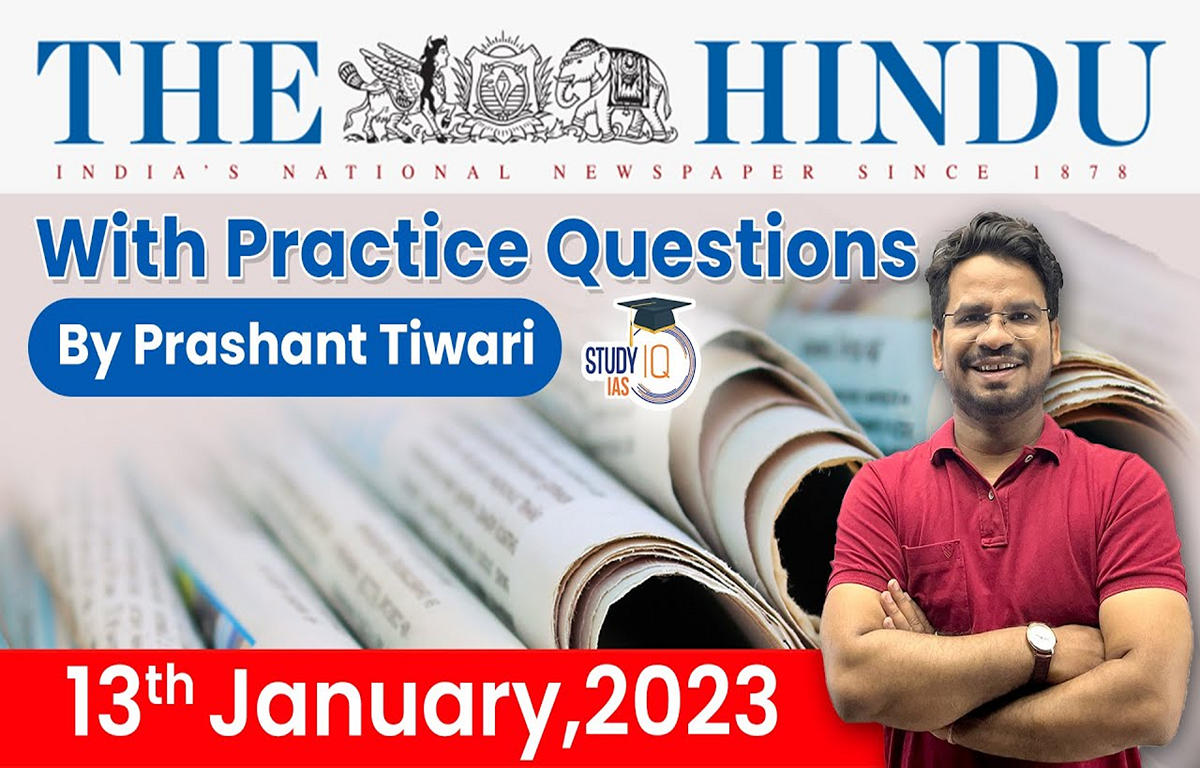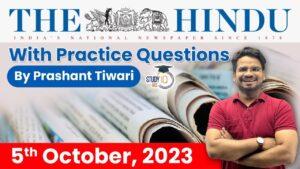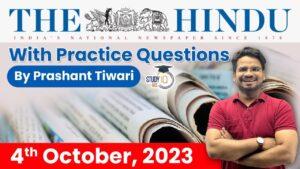The Hindu Newspaper Analysis for UPSC

The Hindu Newspaper Analysis 11 January 2023
- A steep 15.1% fall in vegetable prices in December 2022 drove down India’s retail inflation to a 12-month low of 5.72% — keeping it below the central bank’s 6% tolerance threshold for the second straight month after a ten-month streak above it.
- There was, however, little relief beyond vegetables as inflation in food items such as cereals, milk, spices accelerated further to 13.8%, 8.5% and 20.3%, respectively. For rural consumers, inflation remained high at 6.05%, with food prices rising over 5%, compared to just 2.8% in urban India.
- “Excluding vegetables, retail inflation actually rose to 7.2% in December from 7% in November — led by rising prices of cereals, pulses, milk, meat and fish, and fuel,” said Crisil chief economist Dharmakirti Joshi.
- Core inflation, which excludes food and energy, also hardened to 6.1% from 6% in November, which Mr. Joshi termed the “biggest worry”.

- The Consumer Price Index (CPI) is a measure of price changes in a basket of consumer goods and services purchased by households.
- CPI is a numerical estimate based on the rates of a selection of typical objects whose prices are collected on a regular basis.
- The Consumer Price Index (CPI) measures price fluctuations at the consumer level.
- The CPI is published by the National Statistical Office (NSO) under the Ministry of Statistics and Program Implementation.
- The CPI uses a base year set at 2011-2012.
- The CPI is published on a monthly basis.
- The Wholesale Price Index tracks price changes at the producer level (WPI).


- Technically, the Lieutenant Governor has executive control over only the three reserved subjects of police, public order and land; all other subjects (transferred subjects) lie with the elected government.
- But by virtue of being in control of the bureaucracy, and exercising the power to transfer, suspend or take any action against any employee of the Delhi government, the Lieutenant Governor’s authority extends beyond those.
- The status of Delhi being a Union Territory under Schedule 1 of the Constitution but christened the ‘National Capital Territory’ under Article 239AA, engrafted by the Constitution (69th Amendment) Act.
- The 69th amendment to the Constitution of India inserted Article 239AA, which declared the Union Territory of Delhi to be administered by a L-G who works on aid and advice of the elected legislative assembly.
- However, the ‘aid and advice’ clause pertains only to matters on which the elected Assembly has powers under the State and Concurrent Lists With the exception of public order, police, and land.
- Further, the Article 239AA also notes that L-G has to either act on the aid and advice of the Council of Ministers, or he is bound to implement the decision taken by the President on a reference being made by him.
- Also, Article 239AA, empowers the L-G to refer a difference of opinion on ‘any matter’ with the Council of Ministers to the President.

- There could be several other fallouts as well. Already, the ‘proxy war’ between the U.S., Europe and NATO on the one hand, and Russia on the other, is having a major fallout in the economic realm. The incessant imposition of sanctions by the West and its allies on Russia, the barring of Russian banks from SWIFT, and the freezing of Russian foreign assets have all provoked an energy crisis.
- The ripple effects of the recent developments in Europe are evident. Some of this is occurring well beyond European shores. China-Russia relations are a case in point. China has chosen this time to deepen its strategic ties with Russia. Both countries have said their “relations are enjoying the best period in their history”. Furthermore, in the light of the heightened concerns of the West over Taiwan, newer alignments are becoming evident across Asia.
- Estimated spending on defence across the globe is understood to have crossed $2 trillion in 2022, and is expected to increase substantially in 2023. European countries, such as Germany and France, have announced substantial increases in defence spending. Japan has already declared that it would raise its defence budget to 2% of its GDP, in view of the threats posed by China and North Korea. India, one of the world’s leaders in defence spending, can be expected to follow suit.
- Going ahead, and apart from Europe, China, India and parts of Asia are likely to face major headwinds.
- For India, the altered shape of the international order leaves little room for comfort. The China-Russia entente creates a dent in India’s long-standing strategic relationship with Russia, the impact of which could be far reaching. Meanwhile, the absence of settled borders with both China and Pakistan will continue to plague India.

- Budget is the government’s blueprint on expenditure, taxes it plans to levy, and other transactions which affect the economy and lives of citizens.
- According to Article 112 of the Indian Constitution, the Union Budget of a year is referred to as the Annual Financial Statement (AFS).
- The Budget Division of the Department of Economic Affairs in the Finance Ministry is the nodal body responsible for preparing the Budget.


- The public criticism aired by Vice-President Jagdeep Dhankhar on the National Judicial Appointments Commission (NJAC) judgment may be seen as comments by a high constitutional authority against “the law of the land”.
- The Supreme Court has held that its judicial pronouncements lay down the law. Article 141 of the Constitution mandates that a law declared by the Supreme Court is binding on all courts, even the Supreme Court.
- A Bench of Justices S.K. Kaul and A.S. Oka has told the Attorney-General to advise the government and constitutional authorities that “it is necessary that all follow the law as laid down by this court; otherwise sections of society may decide to follow their own course…”
- Now, Mr. Dhankar had remarked that judicial review, as in the case of the NJAC law, diluted parliamentary sovereignty. He had used terms such as “one-upmanship”. He had said he did not “subscribe” to the landmark Kesavananda Bharati judgment of 1973 which had propounded the idea of the Basic Structure, upheld judicial review and limited the Parliament’s power under Article 368 to amend the Constitution.
- Yet, the very same Kesavananda Bharati verdict had made it clear that judicial review is not a means to usurp parliamentary sovereignty but only part of a “system of checks and balances” to ensure constitutional functionaries do not exceed their limits.
- “We are unable to see how the power of judicial review makes the judiciary supreme in any sense of the word. This power is of paramount importance in a federal Constitution. Indeed, it has been said that the heart and core of a democracy lies in the judicial process,” the top court had observed in the Kesavananda Bharati judgment.

- The World Report 2023 of Human Rights Watch (HRW), released on Thursday, said that Indian authorities had “intensified and broadened” their crackdown on activist groups and the media through 2022.
- ‘Laws misused’
- Meanwhile, the HRW noted the increasingly liberal steps taken by the Supreme Court in India, citing the ruling to halt all use of the colonial-era Sedition law and banning of the two-finger tests to protect survivors of sexual assault.
About Human Rights Watch:
- Founded in 1978, it is an international non-governmental organization, headquartered in New York City, that conducts research and advocacy on human rights.
- The group pressures governments, policy makers, companies, and individual human rights abusers to denounce abuse and respect human rights, and the group often works on behalf of refugees, children, migrants, and political prisoners.
- Headquartered in New York
- Human Rights Watch in 1997 shared in the Nobel Peace Prize as a founding member of the International Campaign to Ban Landmines and it played a leading role in the 2008 treaty banning cluster munitions.
Q) The confluence of Alaknanda and Dhauliganga is at:
- Karna Prayag
- Vishnu Prayag
- Rudra Prayag
- Nanda Prayag
अलकनंदा और धौलीगंगा का संगम है:
- कर्ण प्रयाग
- विष्णु प्रयाग
- रुद्र प्रयाग
- नंद प्रयाग
Explanation:
- Vishnuprayag is one of the Panch Prayag (five confluences) of Alaknanda River, and lies at the confluence of Alaknanda River and Dhauliganga River, in Chamoli district in the Indian state of Uttarakhand.
Q) In which state is the Parshuram Kund Festival celebrated?
- Arunachal Pradesh
- Manipur
- Tripura
- Nagaland
परशुराम कुंड महोत्सव किस राज्य में मनाया जाता है?
- अरुणाचल प्रदेश
- मणिपुर
- त्रिपुरा
- नागालैंड
Explanation:
- The Prime Minister has shared glimpses of Parshuram Kund Festival in Arunachal Pradesh.
- About Parshuram Kund:
- A Hindu pilgrimage on the Brahmaputra plateau in the lower reaches of the Lohit River.
- Religious importance: Dedicated to sage Parshuram
- Government Initiatives:
- The project “Development of Parasuram Kund, Lohit District Arunachal Pradesh” was approved by the Ministry of Tourism in January 2021.
- The project is sanctioned under the Pilgrimage Rejuvenation and Spiritual, Heritage Augmentation Drive’(PRASHAD) Scheme of Ministry of Tourism.
Q) Consider the following statements about BIND Scheme:
- It is a central sector Scheme.
- It aims to actively enhance interaction between people of diverse cultures living in different States and UTs in India.
Which of the above statements is/are correct?
- 1 only
- 2 only
- Both 1 and 2
- Neither 1 nor 2
BIND योजना के बारे में निम्नलिखित कथनों पर विचार करें:
- यह एक केंद्रीय क्षेत्र की योजना है।
- इसका उद्देश्य भारत में विभिन्न राज्यों और केंद्रशासित प्रदेशों में रहने वाले विविध संस्कृतियों के लोगों के बीच संपर्क को सक्रिय रूप से बढ़ाना है।
उपरोक्त कथनों में से कौन-सा/से सही है/हैं?
- केवल 1
- केवल 2
- 1 और 2 दोनों
- न तो 1 और न ही 2
Explanation:
- Broadcasting Infrastructure and Network Development (BIND) is a central sector Scheme (100% Central funding) to modernize the public broadcaster Prasar Bharati (under which comes All India Radio (AIR), Door darshan (DD) and other channels)
- Objectives:
- To widen Prasar Bharati’s reach, including in the LWE (Left Wing Extremism), border and strategic areas and provide high-quality content to the viewers.
- To increase the coverage of AIR FM in the country to 66% by geographical area and 80% by population (currently 59% and 68% respectively)
- Free distribution of over 8 lahks DD Free Dish STBs (Set Top Box) to people living in remote, tribal, LWE and border areas.
Q) Sakhalin-1 Oil and Gas Project is located in:
- Russia
- Germany
- Japan
- K
सखालिन-1 तेल और गैस परियोजना अवस्थित है:
- रूस
- जर्मनी
- जापान
- यू.के
Explanation :
Recently, ONGC Videsh Ltd, the overseas arm of state-owned Oil and Natural Gas Corporation (ONGC), has re-taken a 20 per cent stake in the Sakhalin-1 oil and gas fields in the far east region of Russia.
About:
- The Sakhalin-1 oil and gas development project is located in the Okhotsk Sea, off the north-eastern coast of Sakhalin Island in the Russian Far East.
- It comprises three offshore fields namely Chayvo, Odoptu, and Arkutun-Dagi.
- The Sakhalin-1 project is operated by Exxon Neftegas (ENL), a subsidiary of Exxon Mobil which holds a 30% participating interest. The other partners of the project are the Japanese consortium Sakhalin Oil and Gas Development Company (SODECO, 30%), India’s state-owned ONGC Videsh (20%), and Russian oil company Rosneft (20%).
- The Sakhalin 1 project is estimated to hold approximately 2.3 billion barrels of oil and 17.1 trillion cubic feet (Tcf) in recoverable reserves.
Q) With reference to the Ozone, consider the following statements:
- It is composed of three atoms of oxygen molecules.
- It is only found in the stratospheric zone.
Which of the above statements is/are correct?
- 1 only
- 2 only
- Both 1 and 2
- Neither 1 nor 2
ओजोन के संदर्भ में निम्नलिखित कथनों पर विचार कीजिये:
- यह ऑक्सीजन के अणुओं के तीन परमाणुओं से बना है।
- यह केवल समतापमंडलीय क्षेत्र में पाया जाता है।
उपरोक्त कथनों में से कौन-सा/से सही है/हैं?
- केवल 1
- केवल 2
- 1 और 2 दोनों
- न तो 1 और न ही 2
Explanation :
The recent United Nations report, Scientific Assessment of Ozone Depletion: 2022 said that the Earth’s ozone layer is slowly recovering.
- The successful phasing out of banned substances as envisioned by the Montreal Protocol has set the stage for a complete recovery of the ozone layer by the 2060s, a United Nations-backed panel of experts said at the American Meteorological Society’s annual meeting on January 8, 2023.
What is Ozone?
- Ozone is a gas composed of three atoms of oxygen. It is both a natural and a man-made product that occurs in the Earth’s upper atmosphere (Stratospheric ozone) and lower atmosphere (the troposphere).
- Stratospheric ozone is formed naturally through the interaction of solar ultraviolet (UV) radiation with molecular oxygen (O2).
- The “ozone layer,” approximately 6 to 30 miles above the Earth’s surface, reduces the amount of harmful UV radiation reaching the Earth’s surface.
Mains Practice Question:
Q) Discuss the role of women in the freedom struggle especially during the Gandhian phase. (2016) (250 words)
स्वतंत्रता संग्राम में विशेषकर गांधीवादी दौर में महिलाओं की भूमिका की चर्चा कीजिए। (2016) (250 शब्द)
Introduction:
- Women’s participation in India’s freedom struggle began as early as in 1817. While women were involved in the political arena since the foundation of Indian national congress days (Annie Besant started Home Rule League) and especially during the Swadeshi movement but it was Gandhiji who initiated the mass participation of women in freedom struggle.
Body:
Role played by women in freedom struggle:
Before Gandhian phase:
- Bhima Bai Holkar fought bravely against the British colonel Malcolm and defeated him in guerrilla warfare.
- Maharani Velu Nachiyar (1730 – 1796) bravely fought with the British army decades before the 1857 Revolt. She probably remains the only queen to have defeated the British army successfully.
- Gauri Parvati Bai who was queen of Travancore carried out reforms and emphasized on the need for education of girls thus in many ways helping women elevate from social and educational stigma.
- The role of Rani of Ramgarh, Rani Lakshmi Bai, Tapasvini Maharani in the War of Independence (the Great Revolt) of 1857 was commendable.
During Gandhian phase:
- Role in Gandhi led mass movement: Many women played a proactive role in Gandhian movements. Kasturba Gandhi imprisoned for participating in Quit India Movement and consequently died in Poona Jail. Vijaya laxmi Pandit actively participated in all civil disobedience movement (1932,1941) and got arrested. Raising voice of freedom at International level: Bhikaji Cama organized free India Society in UK and called as Mother India’s first cultural representative of USA. Vijay laxmi Pandit raised Indian voice at San Francisco UN meeting. Sarojni Naidu participated in round table conference along with Gandhi and Nehru.
- Social and Women Mobilisation: Women played an important role in mobilisation by leading from the front and through their writings. Prominent women like Aruna Asaf Ali was the leading figure of Quit India movement and edited journal ‘inquilab for mobilization. Similarly Raj Kumari Kaur was the founder of All India Women’s Conference.
- Revolutionary movements: Some Indian women also took revolutionary steps against imperial rule. Kalapana datta was the prominent revolutionary leader and was part of Chittagong armoury raid. Rani Gaidineliu led the naga nationalist movement against British and known as ‘Queen of Naga’.
- As Indian National Congress leaders: Anne Besant, Irish lady and Sarojini Naidu emerged as an important national leader who later became the President of INC.
Conclusion:
- Hence Women played an indispensable role in Indian freedom struggle ranging from a figure of common person to lead the Mass movement and such contribution is non measurable and non-quantifiable.
Q) Mains Practice Question:
Identify five ethical traits on which one can plot the performance of a civil servant. Justify their inclusion in the matrix. (150 words)
पाँच नैतिक लक्षणों की पहचान करें जिनके आधार पर एक सिविल सेवक के प्रदर्शन की रूपरेखा तैयार की जा सकती है। आव्यूह में उनके समावेशन का औचित्य सिद्ध कीजिए। (150 शब्द)


 The Hindu Newspaper Analysis 6 October 2...
The Hindu Newspaper Analysis 6 October 2...
 The Hindu Newspaper Analysis 5 October 2...
The Hindu Newspaper Analysis 5 October 2...
 The Hindu Newspaper Analysis 4 October 2...
The Hindu Newspaper Analysis 4 October 2...

















